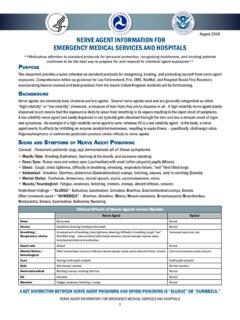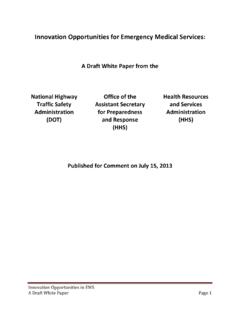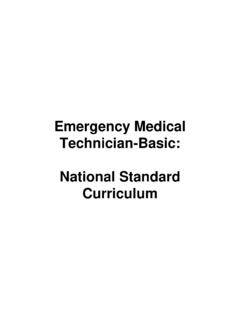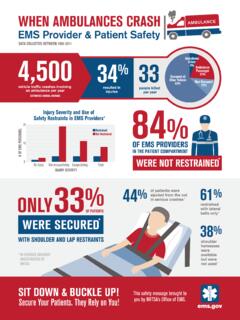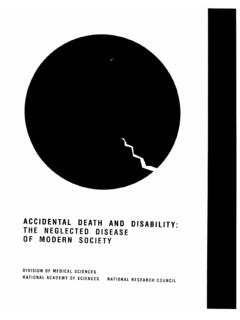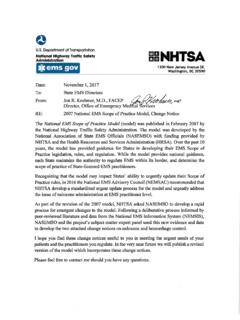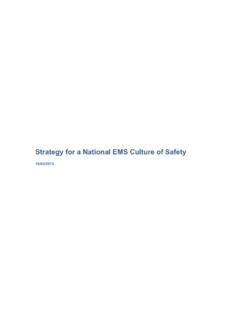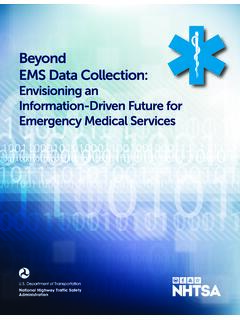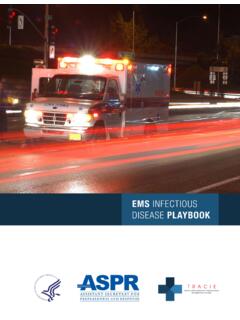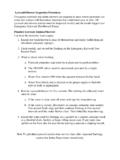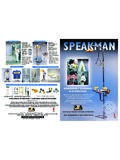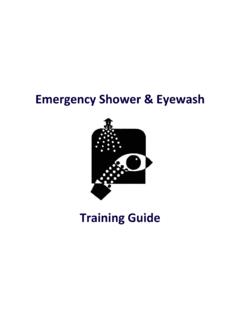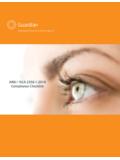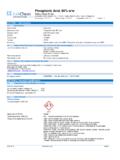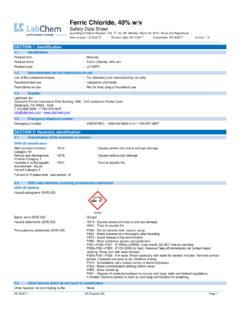Transcription of National Emergency Medical Services Education …
1 National Emergency Medical Services Education StandardsEmergency Medical Responder Instructional GuidelinesPage 1 of 127 Preparatory EMS Systems EMR Education Standard Uses simple knowledge of the Emergency Medical Services (EMS) system, safety/well-being of the Emergency Medical Responder (EMR), Medical /legal issues at the scene of an Emergency while awaiting a higher level of care. EMR-Level Instructional Guideline I. The Emergency Medical Services (EMS) System A. The Current EMS Systems 1. Types of systems in EMS a. Fire-based b. Third service c.
2 Hospital-based 2. Delivery may be different but the goal is the same based upon community needs/resources B. National Highway Traffic Safety Administration (NHTSA) Is Lead Coordinating Agency C. Access to the Emergency Medical Services 1. Public Safety Access Point (PSAP) 2. Most communities access through 9-1-1 D. Education 1. National Scope of Practice Model a. Description of the profession b. Prehospital personnel levels 2. National EMS Education standards E. Authorization to Practice 1. State EMS office a. Determines scope of practice b.
3 Licenses prehospital personnel 2. Medical oversight a. Protocols b. Quality improvement c. Administrative 3. Local credentialing 4. Employer policies and procedures II. Roles, Responsibilities, and Professionalism of EMS Personnel A. Roles and Responsibilities 1. Maintain equipment readiness Page 2 of 127 2. Safety a. Personal b. Patient c. Others on scene 3. Provide scene evaluation and summon additional resources as needed 4. Gain access to the patient 5. Perform patient assessment 6. Administer Emergency Medical care while awaiting arrival of additional Medical resources 7.
4 Provide emotional support a. Patient b. Patient family c. Other responders 8. Maintain continuity of care a. Definition b. EMR is the first step in the EMS care ladder 9. Maintain Medical and legal standards and assure patient privacy 10. Maintain community relations B. Professionalism 1. Characteristics of professional behavior a. Integrity b. Empathy c. Self-motivation d. Appearance and hygiene e. Self-confidence f. Knowledge of limitations g. Time management h. Communications i. Teamwork j. Respect k. Tact l. Patient advocacy m. Careful delivery of care 2.
5 Maintaining certification a. Personal responsibility b. Continuing Education c. Skill competency d. Criminal implications e. Fees III. Quality Improvement A. Dynamic System for Continually Evaluating and Improving Care 1. Patient safety 2. Significant one of the most urgent health care challenges 3. How errors happen a. Skills-based failure Page 3 of 127 b. Rules-based failure c.
6 Knowledge-based failure 4. How you can help reduce errors a. Debrief calls b. Constantly question assumptions c. Use decision aids d. Ask for help Page 4 of 127 Preparatory Research EMR Education Standard Uses simple knowledge of the EMS system, safety/well-being of the EMR, Medical /legal issues at the scene of an Emergency while awaiting a higher level of care. EMR-Level Instructional Guideline I. Impact of Research on EMR Care A. Research Findings Are Important to Identify What Should Be Changed in EMS Assessment and Management and to Improve Patient Care and Outcome ( CPR guidelines change based on current research ) B.
7 Quality Assurance Research For An EMS System Can Improve Service Delivery C. Data Collection Page 5 of 127 Preparatory Workforce Safety and Wellness EMR Education Standard Uses simple knowledge of the EMS system, safety/well-being of the EMR, Medical /legal issues at the scene of an Emergency while awaiting a higher level of care. EMR-Level Instructional Guideline I. Standard Safety Precautions A. Baseline Health Assessment 1. Before working in health care, have a physical examination to determine baseline health status 2. Immunizations should be current while practicing in health care a.
8 Tetanus b. Hepatitis B c. Measles/mumps/rubella (German measles) d. Chicken pox (varicella) e. Influenza 3. Screening for tuberculosis recommended B. Hand washing C. Adherence to Standard Precautions/OSHA Regulation D. Safe Operation of EMS/Patient Care Equipment E. Environmental Control F. Occupational Health and Blood borne Pathogens 1. Immunizations 2. Sharps II. Personal Protective Equipment A. Exposure to Diseases Spread Through Blood or Body Fluids or by Respiratory Droplets Are Best Prevented by the Use of Standard Precautions B. Standard Precautions 1.
9 Hand hygiene a. The most important measure to prevent the spread of infection b. Wash your hands after gloves are removed c. Hand cleansing i. soap and water ii. alcohol-based hand rub d. Cleanse hands with soap, and dry hands thoroughly e. Cleanse hands and other exposed skin immediately if they are exposed to contaminants, such as blood and body fluids or after use of the toilet Page 6 of 127 2. Gloves a. Wear gloves for patient contacts where there is a risk of exposure to blood or body fluids b. If EMR has a latex allergy use an alternative type of glove 3.
10 Eye protection or face shield a. Goggles or full-face shield b. Use if there is a risk of splash or spray of body fluids i. reduces risk of contamination of eyes, nose, or mouth ii. examples include care of patients who are a) bleeding profusely b) delivering a baby 4. Masks a. High-efficiency particulate air (HEPA) or N95 mask on EMR b. Surgical mask on patient 5. Gown a. In situations with large amounts of blood or body fluids, disposable gown should be worn b. If clothing becomes contaminated i. remove as soon as possible ii. shower as soon as possible iii.
